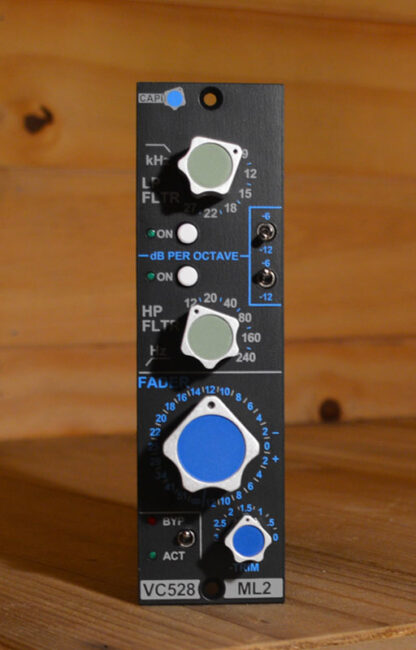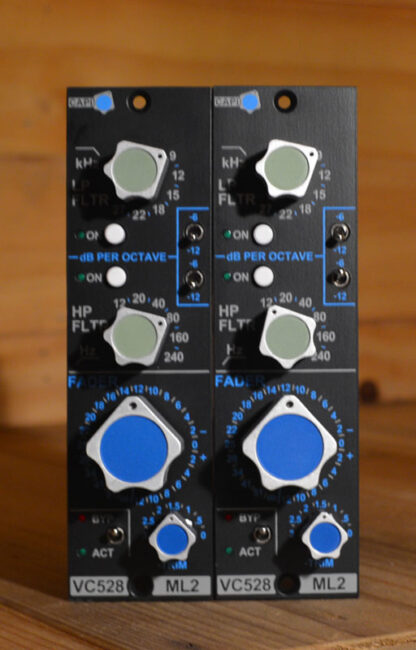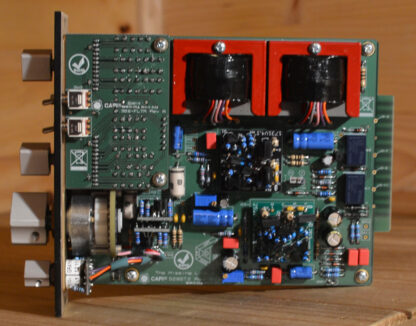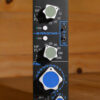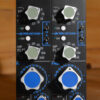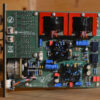CAPI VC528 ML2-Litz
$825.00 CAD – $940.00 CAD
This is the famous ‘Audio Bacon’ 500 series processors. The VC528 recreates the sound of a vintage API console channel, but with the added benefit of versatile high and low pass filters. The filters are grayhill switches, individually bypassable, and have the option of 6 or 12db per octave.
From CAPI :
The overall goal of the VC528 is to achieve the complete and lovely sound of a vintage API console channel without the cost of the rest of the console. It is definitely a little something different for the 500/51x format. Basically, it is a two stage console channel with the vintage circuitry of my API board.
The first stage is a 2520 style balanced, transformerless receiver. Everything is true to the original console circuit.
Next in the block diagram comes the fader. Due to space constraints and a request from a friend, I have chosen to use a 24 position Elma with a 1K overall value. Original faders in my board were 600ohm. The fader has 12dB of gain in hand to keep with the vintage API norm. Since the majority of the upper range gain steps are in 2dB increments, I have used a stepped Grayhill for a fader trim that is in 0.5dB increments.
I follow this filter stage with a 3 transistor discrete voltage follower using 5087/5088’s. This buffer circuit is very reminiscence of the buffer amp used 4 times in the 550a. Very handy indeed.
Next in line is a 6 position stepped LP filter. This filter was not in my board. I have however implemented the same passive philosophy that they used for the HP filter that was in my board. Since it was easy to implement, I have added a switch to select 6dB or 12dB per octave for the filters. Very smooth and natural sounding, by the way.
A second 3 transistor follower is used to buffer the high and low pass filters from each other.
Next is a 6 position stepped HP filter. This filter can also be switched between a 6dB or 12dB slope per octave. Again, the overall philosophy is the very same that was used in my old board.
The last stage is the post fader booster amp. Again, the same circuit as found in the vintage console. I have modified the feeback R and C to provide unity gain when using the entire VC528 circuit.
The relay bypass has a shunt jumper connected to the Pin-6 DC bus so any adjacent ML2’s can be bypassed by activating the toggle on only one unit.
The VC528 modules have been given a few nicknames by some happy users. They have been referred to as “Audio Bacon” as well as “The Missing Link”.
• An individual on/off pushbutton for a quick and easy bypass of either one or both filters.
• Six-position rotary switches, passive HP and LP filters
• A 2-position toggle Active/Bypass that operates a hard-wire relay.
• A discrete follower between the stepped trim switch and the LPF to prevent any interaction.
• The post fader booster amp has a gain trimmer to precisely set the ML2 to unity gain.v, small Grayhill rotary switch
• 24-position Elma fader
• Uses discreet opamps in the receiver and output gain stages
The most common configuration for the opamps is the gar2520 and gar1731. This creates the most balanced tone, which is ideal for bus duties if you don’t want to change the frequency response. Alternatively using dual gar2520’s will get you the closest to the vintage API console sound, and will be slightly more colored. You can check our other opamp options available on this site or ask us.
API (and compatible) Lunchbox and VPR500 racking systems.
Fully built to perfection in Canada with a 1 year warranty.
These can be also build to order.
